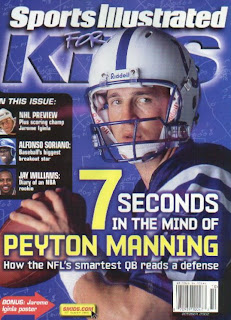
-->
Title: Sports Illustrated for Kids
Author: Various
Managing Editor: Bob Der
Published by Time Inc.
Publications per year: 11 (monthly,
except January/February combined issue)
ISSN: 1042-394X
Audience Ages 8-15, Grades 2-8
Summary: This is a nonfiction
magazine about sports. It features
articles about sports figures, teams, and other news including an article that
comes from the pages of Sports Illustrated.
Regular features include a “Freeze Frame” section with photographs of
sports action, pull out cards and posters, Tips from Pros where professional
athletes give advice to kids, and an End Zone section with puzzles and a comic.
The magazine asks for kids to send humorous captions for photographs, drawings
of athletes, and ideas for Sportskids of the Month through their website.
Strengths: This is high-interest material, especially for
boys and reluctant readers. The articles are well-written with some challenging
language (an example quote: “James has already begun to chisel out a prominent
place for himself in basketball history”), and the crossover to Sports
Illustrated would encourage older students that they were not reading something
aimed at young children. There are great illustrations, but there is a lot of
content here too.
Weaknesses: Obviously, the material
does not have a lot of crossover with curriculum, beyond perhaps biography. The
high level of readability could be a challenge if younger students or
non-readers tried to tackle it, and a teacher or librarian should make sure that
they are not frustrated. Many of the public library issues that I reviewed had
the pull out cards and posters removed by patrons.
Uses: Magazines are an excellent
choice for ESOL students, learning disabled students, and struggling readers.
Sports are a particular interest of many children, especially many boys, so
this magazine would be a good choice for many reluctant readers as well.
Teachers and librarians often recommend magazines for independent reading or
DEAR (Drop Everything and Read) time during school hours. The issues also
contain many charts, graphs, and other graphics that could be used as examples
of text features (CCSS ELA:RI.8 Grades 4-6).
Magazines also use different types of text structure that could be analyzed
by students (CCSS ELA:RI.5 Grades 4-6).
PE teachers could use the articles about different athletes and sports
as inspiration for the students.
Awards:
Parents’ Choice Gold Award
Distinguished Achievement Award
Winner Association of Educational Publishers
Read Alikes (all magazines)
·
Boys’ Life
·
Junior Baseball
·
Odyssey
·
SportingKid
Other:
Website http://siforkids.com/
No comments:
Post a Comment